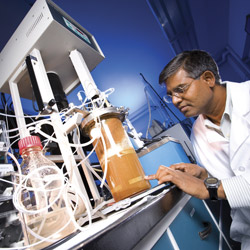Research from the U.S. Heartland to the World

With ongoing research relationships that span every continent, a steady stream of international visitors exploring new opportunities, leadership positions in worldwide professional societies and a multicultural scientific workforce, global collaborations are a staple of daily life at the USDA National Center for Agricultural Utilization Research (NCAUR) in Peoria.
Operated by the USDA’s Agricultural Research Service (ARS) and known locally as “The Ag Lab”, NCAUR opened its doors in December 1940 and began a partnership with British scientists in July 1941. This partnership resulted in the mass production of penicillin and worldwide introduction to the age of antibiotics.
At that time, the identification of microbial cultures was painstakingly slow and conducted over a period of many days. Today, DNA sequencing allows researchers to make identifications within hours.
“We were one of the few facilities using the sequencing technology in the late 1980s. Our use included building a database of genetic information on thousands of microbes,” notes Dr. Cletus Kurtzman, research leader, microbiologist and curator of the ARS Microbial Culture Collection housed at the Peoria lab. “Scientists came from around the world to learn about what we were doing. As they continued working in this arena, they contributed back to our database and increased the overall understanding of microbial germplasm and its biological potential.”
That database, built through years of global contribution, is now the foundation of many rapid detection methods used around the world to identify useful and harmful microbes. The database can also be used to show genetic relationships and predict the possibility of new biotechnological uses.
Today, the ARS Microbial Culture Collection contains nearly 90,000 strains of bacteria, yeasts and molds and is widely regarded as the largest and most useful of the publicly available collections. The collection continues to have significant impact on world science. Some 4,000 samples are distributed each year, often with accompanying knowledge to assist countries developing new research programs.
Through another NCAUR program, corn germplasm is exchanged with Nigerian scientists in an effort to provide traits from U.S. corn for increased yield and to obtain traits from Nigerian corn for increased resistance to drought.
“Much of our work is in developing methodologies and technologies that advance the frontiers of science,” notes Dr. Mark Berhow, NCAUR research chemist. “They may not be the next big thing in the news, but they provide the foundations that are so important to scientific progress around the world.”
Berhow has worked with scientists from Brazil to chemically analyze the natural product properties of wild mustard, which has potential for use as a primary ingredient of biodiesel, fertilizer, pesticides and nutritional additives.
Authoring articles for peer-reviewed publications and participation in professional societies provides valuable opportunities for interaction and international collaboration. The 100 Ph.D. researchers at NCAUR have ongoing relationships established in more than 30 countries. Scientists from around the world routinely make arrangements to visit NCAUR and work on projects of high interest, with durations that range from two weeks to two years. Most come to tap into NCAUR expertise; in exchange, their contributions help move NCAUR projects forward.
A recent visit by Taiwanese scientists to work on rice and cassava starch focused on NCAUR’s unique extrusion processing capabilities. “They gain the benefit of our equipment and process knowledge; we have an opportunity to work with a material we don’t usually work with,” says their NCAUR host and research chemist, Dr. Victoria Finkenstadt. “The similarities in our research brought us together, but it was the differences in how the starches behave that were amazing. For example, cassava, a non-food crop in the U.S., may provide an alternative to heavy reliance on corn starch for commercial and industrial product uses."
Most partnerships are initiated at the scientist-to-scientist level. However, cooperative, mutually beneficial research projects between the ARS agency and the international research community are also sources of international collaborations at NCAUR.
One example is the biofuels research agreement between the USDA and China’s Ministry Of Science and Technology to cooperate in establishing processes and infrastructure for conversion of various feedstocks to ethanol. Another is EMBRAPA LABEX-USA, a Brazilian ‘virtual’ laboratory in the U.S. that provides for senior Brazilian scientists to collaborate with ARS staff at host laboratories such as NCAUR. Shared projects at NCAUR have included developing biocontrol methods against insects, chemically converting soybean oil into fuel, and engineering enzymes for more efficiently converting crops into biofuels.
“These scientific exchanges both contribute to and reflect the prestige of NCAUR as a center for international excellence, and that’s important,” says Dr. Mike Cotta, NCAUR research leader and microbiologist. “Our visibility as a world leader in agricultural research is what allows us to continually attract world-class scientific talent to conduct research of significant impact.”
As life has become increasingly globalized, the importance of a closely connected international research community has also increased. The need for renewable fuels and bioproducts, greater crop productivity, safe food supply, enhanced nutritional value of food, environmental stewardship—all of these issues and more are without geographical borders.
“Each scientist needs to roll up our sleeves and work on these things,” says Berhow. “The more people working together, the better, because the problems we face will not be solved by a single institution and one solution is likely interrelated to others.”
As NCAUR researchers publish an average annual total of more than 200 articles for peer-reviewed scientific publications, the lab continues, as it has for nearly 70 years, to extend the excellence of ARS research from the heartland of the United States to the world. iBi

